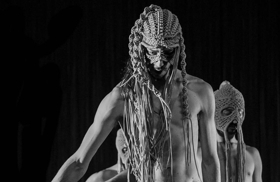Review: BALLET NATIONAL DE MARSEILLE at Avignon's OPERA CONFLUENCE

On the sides and upstage a dense curtain of chains hangs, framing the dance space. It is a stark wasteland. Thankfully, choreographers Emio Greco and Pieter C. Scholten's fascinating movement vocabulary and exciting theatricality rescue the evening's program from becoming a moralizing dirge. The works, Extremalism and Bolero, navigate catastrophe with invention and without pity. In both of the pieces, presented October 6th 2018 at Avignon's Opéra Confluence, the effects of disaster, most noticeably physical exhaustion and emotional disassociation, propel the movement of the incredibly talented performers of the Ballet National de Marseille.
Extremalism begins with a single dancer center stage. Standing perfectly still, they the dancer is lit with a bold flash from an overhead spotlight, and is wearing Clifford Portier's sculptural knit mask. It is a terrifying debut. Entering through the drapes of chains, the rest of the corps enters. Of Greco and Scholten's virtues, their capacity to invent a complex yet unified landscape with an ambitiously large group of dancers is certainly among them. In some, more introspective moments, one could see Extremalism as Serenade's post apocalyptic cousin. The bodily movement was fractured. Arms would flail in pinwheels, and, at times, while walking horizontally like a crab, be lofted limp above the dancer's heads. One had the sense that the corps was possessed by a single alien figure.
Valgeir Sigurosson's musical composition and Pieter C. Scholten's soundscape is at its best when at its most rudimentary. The imperceptible precision of their repetitive phrasings is astonishingly transformed into miraculously coordinated formations by the dancers. Though, an eleventh hour Vivaldi cameo, which featured The Four Seasons at a decibel level which could blow out a speaker system, distracted with questions about the social grounding of this previously timeless space. Clifford Portier's costumes are muted and impersonal. His shocking sculptural masks are paired with floor length robes, which, with sweat, discolor to brown. Extremalism is an aesthetic viewpoint from which one can witness Greco and Scholten's collaborative pallet without impediment.
Bolero, which is choreographed to the Ravel work of the same name, shares aesthetic similarities to Extremalism. In the same scenography and wearing the same costuming one might raise the specter of redundancy. Thankfully the accessibility of Ravel's composition makes the choreographic motif seem entirely new. Bolero is often given fanfare and celebration as its background though the famous composition, with its mounting repetition, is now considered as a result of Ravel's dementia. It would ultimately be one of Ravel's final works. The work is a crescendo to catastrophe. Greco and Scholten's Bolero commands the dancers to exhaustion as they try to escape its rhythmic grasp, transcending its hypnotic pull. A final artistic coup de grace undermines some of this satisfaction. Before the final musical descent the music cuts out as the dancers stand ghostlike downstage. They then walk upstage and exit, lifting the upstage curtain and the final musical descent cuts in. It's a choice that served to undermine narrative catharsis for dramaturgical intention, though, as was the case with Vivaldi in Extremalism, it left me more lost than curious.
As much as it is Bolero, it is also the final sacrifice of Le Sacre du Printemps. Much of the evening's aesthetic belongs to the same world as Bausch's Sacre. As with Extremalism the choreographers' mastery of coordinating large groups without being form-less nor militaristic is astonishing. The work has choreographic plasticity, there is no quotidian action on the stage, though the bodily function remains that of the individual.
Photo by Alwin Poiana
Reader Reviews

Videos

